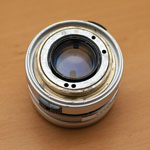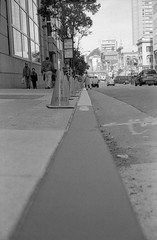
Ages ago I bought a broken Yashica GSN as a parts camera to repair the rangefinder mechanism on my keeper GSN. (You can read about that surgery here)
When I cannibalized the parts camera, I took the lens off (probably the only part of that camera which was in decent shape) hoping to one day adapt it for use on a Leica M body or something similar. Well, the lens wound up, like a lot of my projects, kicking around in a drawer for years and just gathering dust. Then the NEX series of cameras came along and with them adapters for every conceivable lens imaginable. Slooowly, eventually, the dim flashbulb in my head went off, I remembered the long forgotten GSN lens and I got to wondering if and how I could pair it with my NEX 5n.
My main issue always came down to how to focus this little beastie. When I had removed the lens from the GSN, along with disabling the shutter and fixing it in the open position, I removed all the of the focusing mechanism and filed down the lens mount flush with the helicoid. (The holes seen were for wires and a metal rod that triggered the shutter inside the lens.) In hindsight I should have obviously left at least a part of the focusing hardware in place so at this point whatever was going to focus this lens was going to have to be an external thing. |  |
This is where one of my favorite adapters for the NEX series of cameras comes in; Sony E-mount adapters that have a helicoid built in which are meant to allow for close(er) focus with M-mount lenses. These adapters have gotten dramatically cheaper as more Chinese made versions have become available. If you search eBay for “nex helicoid” you will find plenty in the $35-$40 range which is likely the same as the one I have. There is even one that goes for about $18 that can be found by searching for “tinray helicoid”. |  |
At the moment, and as you can see from the photos, this is in the prototype stages, and I am simply using blu-tack to fix the lens to the adapter. I was actually lucky to have removed as much of the focusing mechanism as I did because in this setup with this particular helicoid adapter infinity focus is very close to spot on. It currently focuses just a little bit past infinity, but I plan to shim that when I do the final mounting. The only tricky bit has been to tripod mount the camera and check the focus in the corners to ensure that the lens is fairly aligned with the sensor. Of course, this being blu-tack, it is as easy to push and prod the lens in to a rough alignment as it is to knock it right back out. :-/ Eventually, I want to get a Hawks v3 helicoid adapter (much better quality!) for use on my a7R. I will then use some JB Weld on this adapter to permanently fix the GSN lens to the helicoid. I’ll update this page when that happens. |  |
In the meantime, here is a sample shot with the prototype mounted GSN 45mm f/1.7 lens shot at f/5.6 on a Sony NEX 5n (To view the full size 2464×1638 pixel JPG right-click on the image and open it in a new tab.) 
|
















